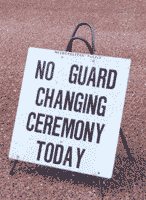
As I See It
Are You Watching the Changing of the Guard?
I see a trend of change in the safety field, and not all of it is good. Some safety professionals are beginning to give up.
CHANGES are commonplace in the safety profession. We are daily faced with constantly changing and improving technology in our profession -- how quickly we seem to have moved from Stone Age to Star Trek technology in recordkeeping and data storage! Occupational standards are generally in place, with needed updates coming in the future. The equipment of safety diagnosis is as solid as ever hoped for, with variety and affordability coming into reach. PPE and PPA are practical, comfortable, and available, usually only a keyboard click or a phone call away. We have accomplished much, with much more left to do to protect our employees.
But what about us -- the heart and soul of the safety profession?
When I attend the national shows and conferences, I look for the familiar faces of safety greats, present and past. The hair is whiter and the step slower now. We are aging, and many are leaving the field, either due to happy things such as retirement or tragedies such as health crises or other catastrophic personal losses. (For example, many safety professionals lost their careers after Hurricane Katrina because the physical industries were gone.) Others are changing fields completely to something less stressful.
I see a trend of change in the safety field, and not all of it is good. Some in our industry are slowly giving up and in the process slowing down the battles for employee safety. Some safety professionals are beginning to give up.
I receive calls and e-mails almost weekly concerning people who not only know the history of safety in their niche of the community . . . they are the history of safety. Newcomers to the profession have the book learning, the youth, and the drive, but many will never fully understand the struggles and sacrifices made by the previous generations of safety professionals who put their names, reputations, and often lives on the line to protect others in the workplaces.
Have you been watching the job postings lately? Top-level safety positions are coming open; others are being "split" into two or more positions. And no wonder: One of the greatest compliments I have received is when the person who assumed my old position when I moved on called me and said, "I can't keep up with everything you had going. How did you do it?"
Which Type Are You?
Being in the profession of safety requires a lot of unique traits, including determination, self-motivation, the ability to work alone, and research skills. Ethics and morals and needed, too. It helps to have thick skin too for all the whining and complaining you will hear.
When newcomers to our industry contact me, I often steer them toward a well-seasoned safety professional in their area or industry who can be a helpful mentor. Even after 20+ years in safety, I still stay in contact with my close circle of mentors and draw from their well of knowledge as often as I can. No longer the new graduate, I am now part of the well-seasoned frying pan of safety and can provide advice and examples to those with less experience. Sometimes, sharing what not to do is as valuable as explaining what to do.
I have often said there are three types of safety professionals: effective, destructive, and those who do nothing. Some are laughable, others are scary. Some leave their doors closed and hope no one knocks for assistance. There are those we love to see and talk to, who challenge us to do better and do more, and those we dread seeing because we know the only objective for them is to "self serve."
In this dynamic moment for safety, which are you?
This article originally appeared in the October 2007 issue of Occupational Health & Safety.
About the Author
Linda J. Sherrard, MS, CSP, is Safety Consultant II with Central Prison Healthcare Complex, NCDPS in Raleigh, N.C., and is the former technical editor of OH&S.